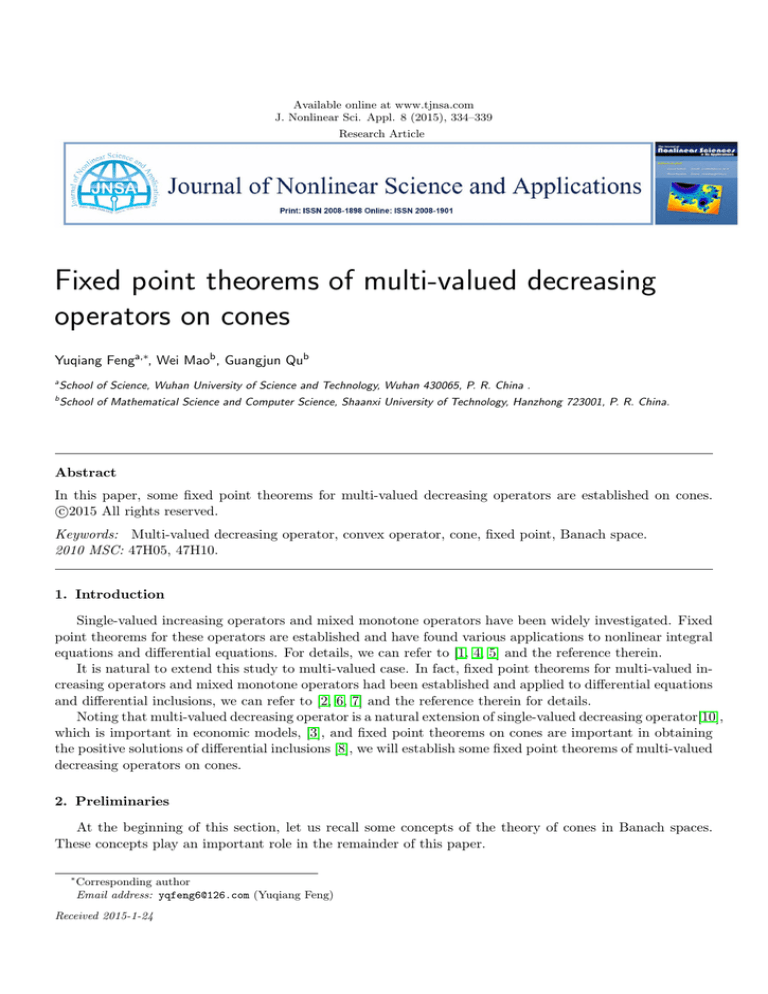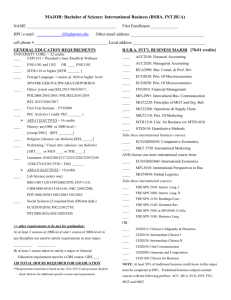
Available online at www.tjnsa.com
J. Nonlinear Sci. Appl. 8 (2015), 334–339
Research Article
Fixed point theorems of multi-valued decreasing
operators on cones
Yuqiang Fenga,∗, Wei Maob , Guangjun Qub
a
School of Science, Wuhan University of Science and Technology, Wuhan 430065, P. R. China .
b
School of Mathematical Science and Computer Science, Shaanxi University of Technology, Hanzhong 723001, P. R. China.
Abstract
In this paper, some fixed point theorems for multi-valued decreasing operators are established on cones.
c
2015
All rights reserved.
Keywords: Multi-valued decreasing operator, convex operator, cone, fixed point, Banach space.
2010 MSC: 47H05, 47H10.
1. Introduction
Single-valued increasing operators and mixed monotone operators have been widely investigated. Fixed
point theorems for these operators are established and have found various applications to nonlinear integral
equations and differential equations. For details, we can refer to [1, 4, 5] and the reference therein.
It is natural to extend this study to multi-valued case. In fact, fixed point theorems for multi-valued increasing operators and mixed monotone operators had been established and applied to differential equations
and differential inclusions, we can refer to [2, 6, 7] and the reference therein for details.
Noting that multi-valued decreasing operator is a natural extension of single-valued decreasing operator[10],
which is important in economic models, [3], and fixed point theorems on cones are important in obtaining
the positive solutions of differential inclusions [8], we will establish some fixed point theorems of multi-valued
decreasing operators on cones.
2. Preliminaries
At the beginning of this section, let us recall some concepts of the theory of cones in Banach spaces.
These concepts play an important role in the remainder of this paper.
∗
Corresponding author
Email address: yqfeng6@126.com (Yuqiang Feng)
Received 2015-1-24
Y. Feng, W. Mao, G. Qu, J. Nonlinear Sci. Appl. 8 (2015), 334–339
335
Let X be a Banach space, a closed convex set P ⊂ X is called a cone, if x ∈ P and x 6= 0 implies
αx ∈ P for α ≥ 0 and αx ∈
/ P for α < 0. A cone defines a partial order in the Banach space X: we write
x ≤ y or y ≥ x if y − x ∈ P . The relation enjoys the following properties: inequalities may be multiplied
by a nonnegative numbers; inequalities of the same kind may be added by terms; one may pass to limit in
inequalities; x ≤ y and y ≤ z implies x = y.
It is well known that if X be a partially ordered Banach space endowed with partial order ≤, then the
subset P = {x ∈ X | 0 ≤ x} is a cone.
Definition 2.1 ([9]). A set M ⊂ X is order bounded with respect to a cone P if there is a y ∈ X such
that x ≤ y for all x ∈ M ; the element y is called an upper bound for M . In the same way we can define a
lower bound.
If the set of upper bounds of M has a minimal elements z, then z is called the least upper bound of M ;
it is denoted by sup M . In the same way we can define the greatest lower bound, inf M .
A cone P is called minihedral, if each two-element set M = {x, y} has a least upper bound, sup{x, y}.
A cone P is called normal, if there is a L > 0, such that 0 ≤ x ≤ y implies k x k≤ N k y k and L does
not depends on x and y. Any such L = L(P ) called a normal constant of P .
For the details of cone theory, see in [9] and references therein.
Definition 2.2 ([2]). Let X be a topology space, 0 ≤0 be a partial order endowed on X, let A, B be two
nonempty subsets of X, the relations between A and B are defined as follow:
(1) If for every a ∈ A, there exists b ∈ B such that a ≤ b, then A ≺1 B;
(2) If for every b ∈ B, there exists a ∈ A such that a ≤ b, then A ≺2 B;
(3) If A ≺1 B and A ≺2 B, then A ≺ B.
Definition 2.3. (1) A multi-valued operator T :X → 2X \{φ}, is called decreasing, if for ∀x, y ∈ X, x ≤ y
implies T y ≺ T x ;
(2) A single-valued operator A:X → X,is called decreasing, if for ∀x, y ∈ X, x ≤ y implies Ay ≤ Ax.
Definition 2.4. (1) A multi-valued operator T :X → 2X \ {φ}, is called convex, if for ∀x, y ∈ P, x ≤ y
implies T (tx + (1 − t)y) ≺ tT x + (1 − t)T y, ∀t ∈ [0, 1]; if −T is convex, then T is called concave;
(2) A single-valued operator A:X → X, is called convex, if for ∀x, y ∈ X , x ≤ y implies A(tx + (1 − t)y) ≤
tAx + (1 − t)Ay, ∀t ∈ [0, 1]; if −A is convex, then A is called concave.
We say that a multi-valued operator T :X → 2X \ {φ} has a closed graph, if un → u0 , vn → v0 , vn ∈ T un
imply v0 ∈ T u0 .
Definition 2.5. Let T be a multi-valued operator, x0 ∈ X is called a fixed point of T , if x0 ∈ T x0 .
3. Main results
In this section, some fixed theorems for multi-valued decreasing operators are proved in partial ordered
Banach space.
Theorem 3.1. Let P be a strongly minihedral normal cone, T :P → 2P \ {φ}, be a multi-valued convex and
decreasing operator. If
S
(1) 12 T θ ≺1 T 2 θ,where T 2 θ = x∈T θ T x and θ denotes the zero element of E;
(2) sup T x ∈ T x for ∀x ∈ P .
Then T has a fixed point in P .
Proof. Define a single-valued operator A : P → P as Ax = sup T x. Since T is convex and decreasing, then
A also is convex and decreasing. In fact
Y. Feng, W. Mao, G. Qu, J. Nonlinear Sci. Appl. 8 (2015), 334–339
336
(1) A is convex, for ∀x, y ∈ P, x ≤ y,
A(tx + (1 − t)y) = sup T (tx + (1 − t)y) ≤ t sup T x + (1 − t) sup T y = tAx + (1 − t)Ay;
(2) A is decreasing, for ∀x, y ∈ P, x ≤ y, T y ≺ T x, then sup T y ≤ sup T x, i.e. Ay ≤ Ax.
If follows from 21 T θ ≺1 T 2 θ, that 21 sup T θ ≤ sup T 2 θ. Since ∀u ∈ T θ, then sup T θ ≤ u. Hence
T (T θ) ≺1 T (sup T θ), which implies sup T 2 θ ≤ sup T (sup T θ), i.e.,
1
1
Aθ = sup T θ ≤ sup T 2 θ ≤ sup T (sup T θ) = A2 θ.
2
2
Now we show A has a fixed point in P .
Let un = An θ, n = 1, 2, · · · . Since A is decreasing and θ ≤ A2 θ, then A3 θ ≤ Aθ,i.e., u3 ≤ u1 , then we
have A2 θ ≤ A4 θ, i.e., u2 ≤ u4 , in the same way, A5 θ ≤ A3 θ, i.e., u5 ≤ u3 . Continue this process, we have
1
u1 ≤ u2 ≤ u4 ≤ · · · ≤ u2n ≤ · · · ≤ u2n−1 ≤ · · · ≤ u3 ≤ u1
2
Let λn = sup{λ|λu2n−1 ≤ u2n }, according to (3.1), we know λn do exist, and
1
λn ≥ , λn u2n−1 ≤ u2n , n = 1, 2, · · ·
2
(3.1)
(3.2)
By the definition of λn and (3.1), we obtain {λn } is increasing and {λn } ∈ [ 12 , 1], then {λn } is convergent.
Let λ = limn→∞ λn , λ ∈ [ 21 , 1].
In what follows, we prove λ = 1, in fact, since A is convex and decreasing, then
u2n+1 = Au2n ≤ A(λn u2n−1 )
= A(λn u2n−1 + (1 − λn )θ)
≤ λn Au2n−1 + (1 − λn )Aθ
= λn u2n + (1 − λn )u1
≤ λn u2n + 2(1 − λn )u2n
= (2 − λn )u2n
so
λ≥
1
2−λn u2n+1
1
2−λ ,
≤ u2n , by the definition of λn , we have λn+1 ≥
1
2−λn ,
hence, we obtain
i.e. −(1 − λ)2 ≥ 0, then λ = 1.
If follows from (3.1) and (3.2) that for arbitrary q, u2n ≤ u2n+q ≤ u2n−1 , so we have
u2n+q − u2n ≤ u2n−1 − u2n ≤ (1 − λn )u2n−1 ≤ (1 − λn )u1 .
(3.3)
Since P is a normal cone and λn → 1, we have the sequences {u2n } and {u2n−1 } are convergence, let
u2n → u∗ , u2n−1 → u∗∗ ,
It follows from (3.2) that u2n ≤ u2n+q ≤ u2n−1+q ≤ u2n−1 , let q → ∞, we obtain
u2n ≤ u∗ ≤ u∗∗ ≤ u2n−1 , n = 1, 2, · · ·
(3.4)
and (3.3), that
u∗∗ − u∗ ≤ u2n−1 − u2n ≤ (1 − λn )u1 → 0, λn → 1
so that u∗∗ = u∗ = x∗ , then u2n ≤ x∗ ≤ u2n−1 , then u2n ≤ Ax∗ ≤ u2n−1 , and since u2n → u∗ , u2n−1 → u∗∗ ,
there exists x∗ ∈ P , such that x∗ = Ax∗ .
By sup T x ∈ T x, we have x∗ ∈ T x∗ .
Y. Feng, W. Mao, G. Qu, J. Nonlinear Sci. Appl. 8 (2015), 334–339
337
Remark 3.2. The following example shows that Theorem 3.1 does not hold without condition of convexity.
Let E = R, P = R+ , T : P → 2P \ {φ} is defined by
9
2x
1
8
− 2x
{y| 13
13 ≤ y ≤ 13 − 13 }, 0 ≤ x < 2 ,
7
7
2x
1
{y| 13
− 3x
T (x) =
13 ≤ y ≤ 13 − 13 }, 2 ≤ x ≤ 1,
4
5
{y| 13
≤ y ≤ 13
},
x > 1.
Then T satisfied all conditions of Theorem 3.1, but the convexity. It is obviously that T does not have
any fixed point.
Remark 3.3. In Theorem 3.1, the condition sup T x ∈ T x was essential, for example, let E = R, P = R+ , T :
P → 2P \ {φ} is defined by
x = 0, x ≥ 1,
(0, 1),
T (x) =
(0, x) ∪ (x, 1), 0 < x < 1.
Then T satisfied all conditions of Theorem 3.1, but sup T x ∈
/ T x. It is obvious that T has no fixed point.
Remark 3.4. In Theorem 3.1, if the condition 12 T θ ≺1 T 2 θ was be substituted by 12 T θ ≺2 T 2 θ, and sup T x ∈
T x be substituted by inf T x ∈ T x, then the existence result still hold.
Theorem 3.5. Let P be a normal cone, T :P → 2P \ {φ} be a multi-valued decreasing operator such that
(1) T has a closed graph;
(2) {x0 } ≺1 T x0 , for some x0 ∈ P ;
(3) There exists a number q ∈ [0, 1) satisfying for x, y ∈ P, x ≤ y that
T y ⊂ T x − P ∩ B(θ, qky − xk)
T x ⊂ T y + P ∩ B(θ, qky − xk),
where B(θ, r) = {x| kxk ≤ r}.
Then T has a fixed point in P .
Proof. From the hypothesis (2) we can find an element x1 ∈ T x0 such that x0 ≤ x1 . From the hypothesis
(3), we have
T x0 ⊂ T x1 + P ∩ B(θ, qkx1 − x0 k).
Then we choose an element x2 ∈ T x1 , so that
kx1 − x2 k ≤ qkx1 − x0 k, x2 ≤ x1 .
From the condition (3), we have
T x1 ⊂ T x2 − P ∩ B(θ, qkx1 − x2 k).
Then we choose an element x3 ∈ T x2 , so that
kx3 − x2 k ≤ qkx2 − x1 k ≤ q 2 kx1 − x0 k, x2 ≤ x3 .
Repeating arguments above for the pair x1 , x2 in place x0 , x1 and so on, we can construct an sequence {xn }
satisfying
kxn − xn−1 k ≤ q n−1 kx1 − x0 k, xn ∈ T xn−1 .
The sequence {xn } is a Cauchy sequence, let xn → x∗ . From the condition (1) and xn → x∗ , xn−1 →
x∗ , xn ∈ T xn−1 . we have x∗ ∈ T x∗ .
Y. Feng, W. Mao, G. Qu, J. Nonlinear Sci. Appl. 8 (2015), 334–339
338
Theorem 3.6. Let the Banach space E be ordered by a normal cone P , and T :P → 2P \{φ} be a multi-valued
decreasing operator, satisfying (1) and (2) in Theorem 3.5. Assume in addition the following hypothesis
(3) There exists a linear operator L : E → E with spectral radius r(L) < 1, L(P ) ⊂ P and satisfying for
x ≤ y that
T y ⊂ T x − [θ, L(y − x)],
T x ⊂ T y + [θ, L(y − x)].
Then T has a fixed point in P .
1
Proof. Since limn→∞ (kLn k) n = r(L), we have kLn k ≤ q n for some q ∈ (0, 1). From the hypothesis (2) we
can find an element x1 ∈ T x0 such that x0 ≤ x1 . From the hypothesis (3), we have
T x0 ⊂ T x1 + [θ, L(x1 − x0 )].
Then we choose an element x2 ∈ T x1 , such that
0 ≤ x1 − x2 ≤ L(x1 − x0 ),
which implies
kx1 − x2 k ≤ N.kLk.kx1 − x0 k.
From the condition (3), we have
T x1 ⊂ T x2 − [θ, L(x1 − x2 )].
Then we choose an element x3 ∈ T x2 , such that
0 ≤ x3 − x2 ≤ L(x1 − x0 ).
which implies
kx3 − x2 k ≤ N.kLk.kx2 − x1 k ≤ N.kL2 k.kx1 − x0 k.
Repeating arguments above for the pair x1 , x2 in place x0 , x1 and so on, we can construct an sequence {xn }
satisfying
kxn − xn−1 k ≤ N.kLn k.kx1 − x0 k, xn ∈ T xn−1 .
The sequence {xn } is a Cauchy sequence, let xn → x∗ . From condition (1) and xn → x∗ , xn−1 → x∗ , xn ∈
T xn−1 , we have x∗ ∈ T x∗ .
Remark 3.7. In Theorem 3.5, Theorem 3.6, the assumption (2) T x0 ≺2 {x0 }, for some x0 ∈ P can be
substituted by (20 ) {x0 } ≺2 T x0 , for some x0 ∈ P .
Acknowledgements
This research is supported by the Doctoral Fund of Education Ministry of China (20134219120003),
the Natural Science Foundation of Hubei Province (2013CFA131) and Hubei Province Key Laboratory of
Systems Science in Metallurgical Process (z201302).
Y. Feng, W. Mao, G. Qu, J. Nonlinear Sci. Appl. 8 (2015), 334–339
339
References
[1] C. Bu, Y. Feng, H. Li, Existence and uniqueness of fixed point for mixed monotone ternary operators with
application, Fixed Point Theory Appl., 2014 (2014), 13 pages. 1
[2] Y. Feng, S. Liu, Fixed point theorems for multi-valued increasing operators in partial ordered spaces, Soochow J.
Math., 30 (2004), 461–469. 1, 2.2
[3] Y. Feng, P. Tong, Existence and nonexistence of positive periodic solutions to a second order differential inclusion,
Topol. Methods Nonlinear Anal., 42 (2013), 449–459. 1
[4] Y. Feng, H. Wang, Characterizations of reproducing cone and uniqueness of fixed point, Nonlinear Anal., 74
(2011), 5759–5765. 1
[5] D. Guo, Partial Order Methods in Nonlinear Analysis, Shandong Science and Technology Press, Jinan (2000). 1
[6] N. Huang, Y. Fang, Fixed points for multi-valued mixed increasing operators in ordered Banach spaces with
applications to integral inclusions, Z. Anal. Anwendungen, 22 (2003), 399–410. 1
[7] N. B. Huy, N. H. Kahanh, Fixed point for multivalued increasing operators, J. Math. Anal. Appl., 250 (2000),
368–371. 1
[8] N. S. Kukushikin,A fixed point theorem for decreasing mappings, Economic Lett., 46 (1994), 23–26. 1
[9] M. A. Krasnoses’kii, P. P. Zabreiko, Geometrical Methods of Nonlinear Analysis, Springer Verlag, Berlin (1984).
2.1, 2
[10] F. Li, J. Feng, P. Shen, Fixed point theorems for a class of decreasing operators and their applications, Acta Math.
Sinica, 42 (1999) 193–196 (in Chinese). 1









